Broke Eating 101, a Blog Post for Cedric
May 20, 2010
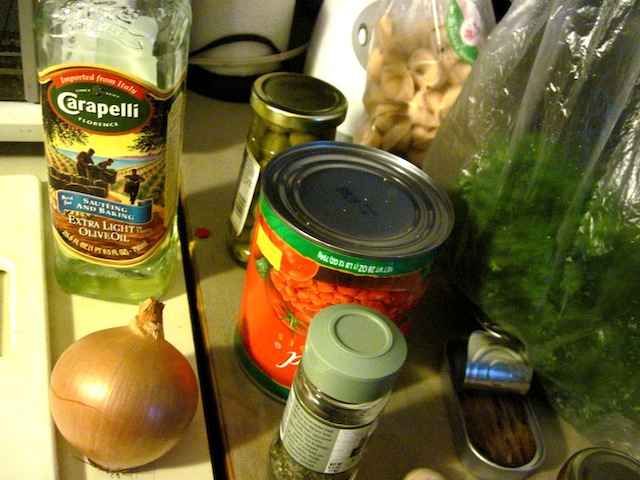
Last night at work, I found myself talking about food. Again. This happens to me often, usually because I bring my own lunch and when someone asks me what it is, I can’t just say “pasta.” I have to say, “bowtie pasta with a sauce of crushed tomatoes, garlic, olives, capers, and onion topped with grated Sicilian black pepper cheese.” And then, invariably, we start talking about food, or I launch into some rhapsodous description of what I made for dinner last night. And, invariably, it’s the same few people who walk in on me, talking about food, again, and say, “Lyz! You’re always talking about food!” I mean, maybe. But I have other hobbies. Really, I do.
But last night, after going on a foodie spiel, I was asked by a co-worker my advice on cooking cheaply and healthily for yourself. He was taking notes. No one had ever taken notes. But, since there’s no better way to make yourself an expert than to just present yourself as one, I launched into an avalanche of advice. Really, I’m no expert (I lied, I’m sorry, forgive me), but I think I do manage to make delicious food for very little money.
And so, in the interest of sharing, here are some basic tenets on my approach to cooking and how I manage to live on mostly nothing.
The Kitchen’s Golden Rule
Banish your fear. Fear is your worst enemy in the kitchen. You don’t need to measure things exactly, you don’t need to use parsley or caviar. Don’t be afraid to experiment and don’t be afraid to not follow a recipe exactly. If you don’t have an ingredient, substitute something else – it might sound strange, but it could be delicious. (See: the other day, I was making a mango milkshake, but was out of yogurt and used sour cream instead and ohmygoditwasamazing.)
Start With the Basics
Some things are easier to make than others. Some things are easier to experiment with than others. If you’re just starting to cook on your own or you want as much variation with as little redundant grocery buying as possible, start with these four things: grain-based salads, sandwiches, pastas, egg dishes. More on this later.
Develop a Good Staple and Spice Collection
This is really the key to making delicious food. Here are some things I always have on hand:
Olive oil – both extra virgin to use cold (especially for salad dressings) and regular for sautéing and drizzling over roasting vegetables
Vegetable oil – for frying and baking
Seasoned rice wine vinegar – goes into every dressing I ever make
Spicy whole grain mustard – same as above
Honey – I like a light-colored honey to sweeten dressings, curries, roasts
Balsamic vinegar – I use this less than rice wine vinegar, but a splash of this is nice in dressings
Sriracha – the best hot sauce in the world, it goes with everything
Soy sauce or Shoyu – great for stir frys, dressings, sautéing vegetables
Mayonnaise – I’m not really big on mayonnaise as a thing itself, but I do use it in cooking as a binder for sandwich fillings or in dressings
Olives – not really a condiment, but I always have some on hand to chop up
Capers – same as with olives; they add such a great, briny flavor to pastas and salads
Peanut butter – the poor man’s power food; you can spread it on bread and use it in sauces for pastas and salad dressings
Brown Sugar – A great sweetener for curries, to make caramelized onions, and in tomato-based sauces
Butter – I mean, a little melted butter, some onions, an egg…
Salt and pepper – duh
Dried herbs – oregano, parsley, rosemary, thyme, basil
Spices – curry powder, berbere, turmeric, crushed red pepper flakes
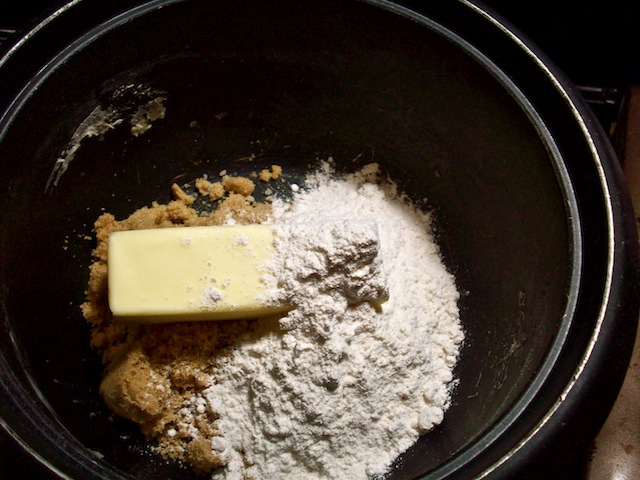
Non-Perishable Foodstuffs I Usually Have
Think of these as your canvas and vegetables and meat as paint. There are so many different types of grains out there that can be way more interesting than just rice and pasta, though those are good too.
Rice – there are so many different types of rice; I prefer white rice for hot dishes and brown rice for salads
Pasta – again, so many types; I like to have a few varieties on hand
Bulgur – delicious hot or cold, beautiful nutty taste
Couscous – also good hot or cold, soaks up the flavor of whatever you put on it
Quinoa – a lot like bulgur, different texture
Grits – great for breakfast, with melted cheese, hot sauce, or buried under eggs
Flour – super basic, great for thickening sauces and baking, of course
Breadstuff – this can include sliced bread, tortillas, or pitas (I know this is perishable, technically, but it fits better in this category…)

Perishable Foodstuffs I Usually Always Have, Too
You can use these things for EVERYTHING, so I try to always have some on hand.
Onions – use sliced, sautéed onions in pretty much everything
Garlic – ditto for garlic, a little bit goes a long way; also great in salad dressings
Potatoes – roasted, sautéed, mashed, and always filling
Parsley – people underestimate the power of garnishes, but there’s so much flavor in parsley and it brightens up any carb-heavy dish
Cilantro – you either love or hate cilantro, but if you love it, use it in salads, tacos, sandwiches, anything cold
Eggs – so versatile, more on these later
Cheese – I usually have a few types of cheese on hand; always a block of parmesan, and then I rotate between brie, feta, goat, blue, and cheddar
Cabbage – hot or cold, stir fry or slaw, another versatile food that lasts forever
Greens – a bunch of greens is so cheap and lasts for over two weeks
Grain-Based Salads
If you’re broke, you need to eat cheap, but you don’t need to sacrifice taste or health for something that’s going to fill you up. The key is grain-based salads. It’s simple: choose a grain (like rice, bulgur or quinoa) and cook it, chop up some veggies (carrots, tomatoes, cabbage, cucumber, beets, jalapenos, cilantro, canned corn, red or green pepper, whatever), make a dressing (olive oil, rice wine vinegar, honey, mustard, salt, pepper, fresh herbs), and mix it all together. Grains are super cheap and a little bit goes a long way, since it’s very filling. So having a salad made with a grain base is great because you don’t need a lot of veggies to make a really great meal. Use this principle to make pasta salads as well.
Sandwiches
There is nothing you can’t put between two slices of bread. Forget sliced deli meat, yellow cheese, and mayo. So boring. Think: crumbled blue cheese or feta, bacon, lettuce, homemade slaw, pequillo peppers, avocado, egg, mushroom – basically any leftovers you have in your fridge, throw it on bread.
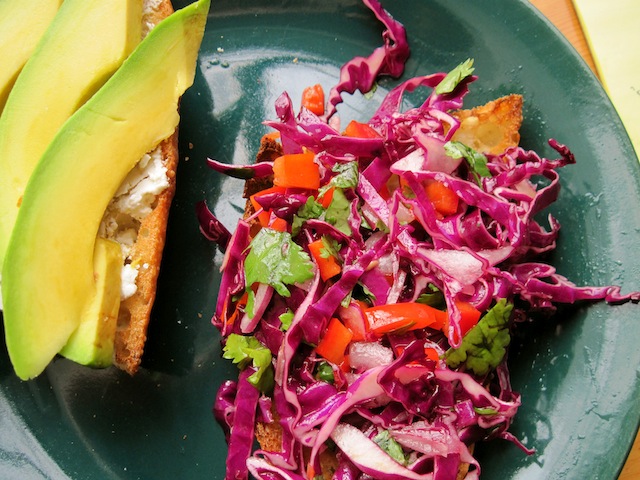
You can even take some of your leftover grain-based salad, put it on a pita and then make a little cabbage and carrot slaw – and bam, you have a wrap. Waste nothing. Put it in a sandwich.

Pastas
What you can’t put in a pasta sauce… Think of pasta sauce as a way to use up leftovers. Nubs of carrots, canned tomatoes, olives, capers, peppers, onions, eggplant, egg – just sauté veggies until soft, cook pasta, toss together. Shave some parmesan on top.
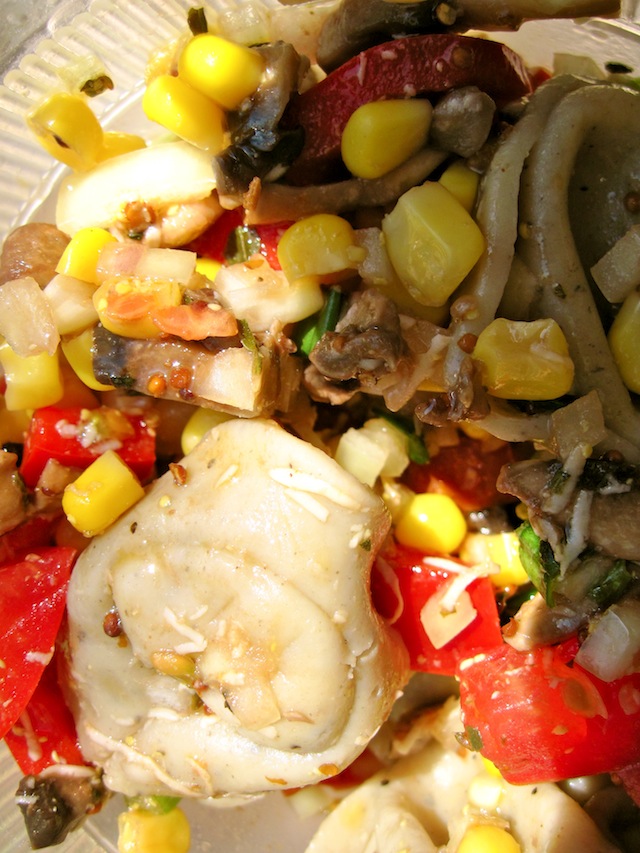
Egg Dishes
Kind of the workhorse of broke cooking. You can put anything in eggs (trend, anyone?). A frittata can include: potatoes, onions, broccoli, greens, leftover pasta, parsley, tomatoes, chicken – or whatever else you happen to find. Just soften everything in a skillet and then crack two eggs into the pan.
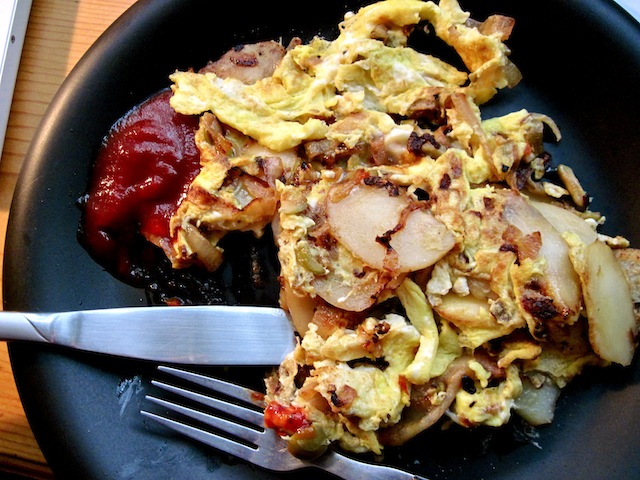
Some Final Thoughts
There’s more. There’s always more. But this is a great place to start if you’re new to cooking for yourself – or if you’re new to not having any money. Especially if you’re new to not having any money and needing to cook for yourself. Remember, just don’t be afraid to do anything and it’ll all turn out ok.
A New Thing
I’d like to ask your input, your advice. We’re all about as expert as each other. What can’t you cook without? What do you always have on hand?
It’s a little different for us because not only are we trying to eat really cheaply but we’re also trying to feed 7 people. Honestly, I think it’s easier to be broke and feeding 7 people than to be broke and feeding 1 – we go through Costco-sized peanut butter jars in a week. Buying in bulk = lifesaver.
Oatmeal + polenta, either just-barely sweet or with a savory theme for breakfasts. I also love to eat leftovers for breakfast. Or oatmeal for dinner. Because why not?
We make a pot of beans every week, usually on Sunday or Monday. We switch up the spices and the kind of bean, and then we use them all week. One day, I will cook up a grain and make a grain bowl. The next, I might add some broth and green onions and have a soup. On day three they might show up in a skillet with some onions and an egg for a wrap.
Soup is our lifesaver – it goes a looong way. Soup with beans, soup with root vegetables, soup with whatever is in the fridge. Soup is my go-to because it’s so forgiving and you can use whatever is in the fridge. Soups were the first things I really felt comfortable cooking, and they’re a great place to learn about ingredients and spices.
We also befriended a baker who has to give away all of her baked goods at the end of the day. Yes, please.
Great practical advice here, Lyz. Simple olive oil-roasted and slightly charred vegetables in season are the kitchen mainstay for any busy, broke cook. (Oil-roasted turnips and onions in winter, for example; roasted green beans in summer are about as cheap as it gets and delicious).I’d add to the broke pantry must-haves: canned tomatoes (both plum and diced), dry and canned black beans and white beans (for white bean/garlic/olive oil puree and for chicken chili), and a jar or two of salsa. And celery with leafy stalks (how can you make any soup without it?) must live in my crisper. If I were marooned on a desert island I’d have to have vanilla extract (the secret ingredient for anything involving cooked fruit), freshly ground nutmeg,crystalized ginger, Colman’s mustard, Jane’s Crazy Salt, coarse-ground pepper, and Chimayo chili pepper or I couldn’t cook anything.
This was super helpful! Thank you.